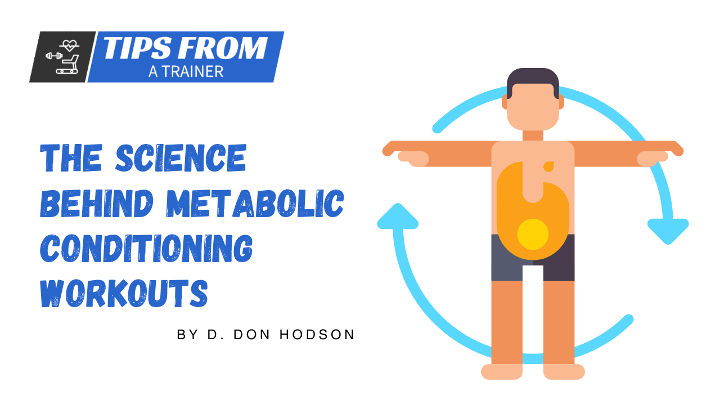Introduction
Metabolic conditioning workouts have gained significant popularity in the fitness world due to their remarkable effectiveness in improving fitness levels and enhancing overall metabolic function. These workouts are carefully designed to optimize the body's energy systems, leading to increased calorie burn, improved endurance, and enhanced cardiovascular fitness.
To truly grasp the potential benefits and make the most of these workouts, it's essential to delve into the underlying science that governs their mechanisms.
This article aims to provide a comprehensive exploration of the scientific principles underlying metabolic conditioning workouts, shedding light on the physiological and metabolic processes at play and how they contribute to your fitness goals.
Table of Contents
Introduction
Understanding Metabolism and Energy Systems
EPOC (Excess Post-Exercise Oxygen Consumption)
High-Intensity Interval Training (HIIT) and Metabolic Adaptations
Complex Compound Movements and Metabolic Demand
Resistance Training and Metabolic Benefits
Energy Systems and Metabolic Conditioning
EPOC and Metabolic Conditioning
Metabolic Adaptations and Long-Term Benefits
Conclusion

Understanding Metabolism and Energy Systems
To understand the science behind metabolic conditioning workouts, it's crucial to have a solid foundation in the concept of metabolism and the energy systems involved in exercise. Metabolism refers to the complex network of chemical processes that occur within the body to convert food into energy. It encompasses two main aspects: anabolism, the building of molecules and tissues, and catabolism, the breakdown of molecules for energy release.
During exercise, the body relies on different energy systems to meet the increased demand for energy. The three primary energy systems involved are the ATP-PCr system (phosphagen system), the glycolytic system, and the oxidative system. The ATP-PCr system provides immediate energy through the breakdown of stored phosphocreatine, allowing for quick bursts of high-intensity activity. The glycolytic system utilizes glucose for energy production and is responsible for providing energy during moderate to high-intensity exercise lasting several minutes. The oxidative system, predominantly fueled by carbohydrates and fats, supplies energy for longer durations of exercise and is crucial for endurance activities.
Understanding the interplay between these energy systems and their utilization during different types and intensities of exercise is key to optimizing metabolic conditioning workouts. By strategically manipulating the intensity, duration, and rest intervals, individuals can target specific energy systems to elicit desired adaptations and improve overall metabolic efficiency.
EPOC (Excess Post-Exercise Oxygen Consumption)
One of the key factors contributing to the effectiveness of metabolic conditioning workouts is the phenomenon known as Excess Post-Exercise Oxygen Consumption (EPOC). EPOC refers to the elevated oxygen consumption and calorie burn that occurs after an intense workout. This post-exercise phase is characterized by an increased metabolic rate, allowing the body to recover, restore homeostasis, and repair damaged tissues.
EPOC is influenced by several factors, including the intensity and duration of the workout, the individual's fitness level, and the type of exercise performed. High-intensity workouts, such as those often incorporated in metabolic conditioning, elicit a greater EPOC effect due to the higher energy demand and subsequent metabolic adaptations.
The increased oxygen consumption during EPOC plays a crucial role in calorie expenditure, as the body requires additional energy to restore oxygen levels, replenish glycogen stores, clear metabolic byproducts, and repair muscle tissue. This extended calorie burn post-workout can contribute to weight management and fat loss goals. Furthermore, EPOC has been shown to enhance the body's ability to utilize stored fat as a fuel source during the recovery period.
By understanding the concept of EPOC and its role in metabolic conditioning workouts, individuals can optimize their training to maximize the benefits of increased calorie burn and metabolic efficiency. Incorporating high-intensity intervals, resistance training, and compound movements into workouts can further enhance the EPOC response, leading to greater overall metabolic adaptations.
These expanded sections provide a more comprehensive understanding of the science behind metabolic conditioning workouts. By delving deeper into metabolism and energy systems, as well as exploring the mechanisms of EPOC, individuals can gain valuable insights into the physiological responses that occur during these workouts. The subsequent sections will further explore specific workout techniques and their scientific foundations to help you design effective metabolic conditioning routines.
High-Intensity Interval Training (HIIT) and Metabolic Adaptations
High-Intensity Interval Training (HIIT) is a fundamental component of metabolic conditioning workouts. It involves alternating periods of intense exercise with short recovery intervals. The key principle behind HIIT is to push the body to its maximum capacity during the high-intensity intervals, activating multiple energy systems and stimulating metabolic adaptations.
During HIIT, the high-intensity intervals challenge the ATP-PCr and glycolytic energy systems, leading to increased energy expenditure and metabolic stress. This results in several physiological responses that contribute to metabolic adaptations. The body adapts by enhancing its ability to produce and utilize ATP, improving muscle strength and endurance, and increasing the efficiency of energy transfer within the cells.
Research suggests that HIIT can significantly improve aerobic and anaerobic capacity, increase insulin sensitivity, and enhance fat oxidation. The intense nature of HIIT also promotes the release of growth hormone, which plays a vital role in muscle development and fat metabolism.
Complex Compound Movements and Metabolic Demand
Incorporating complex compound movements into metabolic conditioning workouts further amplifies the metabolic demand and enhances overall fitness. Complex compound movements involve multiple joints and muscle groups, requiring coordinated efforts and generating a substantial energy expenditure.
Exercises like squats, deadlifts, lunges, bench presses, and overhead presses engage large muscle groups, stimulating the body to produce a greater force and consume more energy. These movements not only increase calorie burn during the workout but also contribute to the EPOC effect, leading to an extended post-workout metabolic boost.
Complex compound movements also trigger the release of anabolic hormones, such as testosterone and growth hormone, which support muscle development and metabolic efficiency. Additionally, they improve movement patterns, functional strength, and overall athletic performance, making them essential components of metabolic conditioning workouts.
Resistance Training and Metabolic Benefits
Resistance training is another vital element of metabolic conditioning workouts. By incorporating resistance exercises, such as weightlifting or bodyweight exercises, individuals can enhance muscular strength, increase lean muscle mass, and boost their metabolic rate.
Resistance training induces microtrauma in muscle fibers, leading to the activation of repair and growth processes. This results in an increased muscle protein synthesis rate, which requires energy and contributes to the overall energy expenditure during and after the workout.
Furthermore, resistance training promotes the development of lean muscle mass, which plays a crucial role in metabolic health. Muscles are metabolically active tissues that require energy even at rest. As the amount of lean muscle mass increases, so does the basal metabolic rate, leading to greater calorie burn throughout the day.
Research indicates that resistance training can improve insulin sensitivity, enhance glucose metabolism, and optimize body composition by reducing body fat and increasing lean muscle mass. The combination of resistance training with high-intensity intervals and complex compound movements in metabolic conditioning workouts creates a powerful synergy that elicits significant metabolic adaptations.
Energy Systems and Metabolic Conditioning
Metabolic conditioning workouts aim to target and improve the efficiency of the body's energy systems. Understanding the different energy systems helps in designing effective workouts that challenge and train these systems.
The three primary energy systems involved in metabolic conditioning workouts are the ATP-PCr system, the glycolytic system, and the aerobic system. Each system provides energy during different intensities and durations of exercise.
The ATP-PCr system supplies energy for short bursts of intense activity, such as explosive movements or sprints. It utilizes stored ATP (adenosine triphosphate) and PCr (phosphocreatine) to produce energy rapidly. Training this system involves short, intense bursts of exercise with brief recovery intervals.
The glycolytic system primarily uses glucose stored in the muscles and liver to generate energy. It is engaged during moderate to high-intensity exercise lasting a few minutes. Metabolic conditioning workouts targeting this system involve exercises that push the limits of anaerobic metabolism, such as interval training and circuit training.
The aerobic system utilizes oxygen to convert stored carbohydrates and fats into ATP to sustain exercise for prolonged periods. Activities like jogging, cycling, or sustained cardio exercises target this system. Metabolic conditioning workouts targeting the aerobic system typically involve longer durations of exercise with moderate intensity.
By incorporating exercises that challenge each energy system, metabolic conditioning workouts optimize the body's ability to generate and utilize energy efficiently, leading to improved overall metabolic health and performance.
EPOC and Metabolic Conditioning
Excess Post-Exercise Oxygen Consumption (EPOC) is a critical component of metabolic conditioning workouts. EPOC refers to the increased oxygen consumption and energy expenditure that occurs after exercise, contributing to additional calorie burn and metabolic adaptations.
Intense metabolic conditioning workouts stimulate EPOC by creating a significant oxygen debt within the body. The body needs to replenish ATP stores, restore oxygen levels, remove metabolic byproducts, and repair damaged muscle tissues. All these processes require energy and result in an elevated metabolic rate for a prolonged period post-workout.
EPOC is influenced by the intensity, duration, and type of exercise performed during the metabolic conditioning workout. High-intensity intervals, complex compound movements, and resistance exercises contribute to a greater EPOC effect compared to low-intensity or steady-state cardio exercises.
The prolonged elevation in metabolic rate during the EPOC phase leads to additional calorie burn, even at rest. This makes metabolic conditioning workouts an effective strategy for weight management and improving body composition.
Metabolic Adaptations and Long-Term Benefits
Consistently engaging in metabolic conditioning workouts can lead to significant metabolic adaptations and long-term benefits. The body becomes more efficient at utilizing energy, improving cardiovascular endurance, and enhancing overall metabolic health.
Metabolic adaptations include an increase in mitochondrial density, which enhances the production of ATP and improves aerobic capacity. The body also becomes more efficient at utilizing fat as a fuel source, leading to enhanced fat oxidation during exercise and at rest.
Regular metabolic conditioning workouts can also improve insulin sensitivity, glucose metabolism, and lipid profile. These adaptations contribute to better blood sugar control, reduced risk of metabolic disorders, and improved cardiovascular health.
Furthermore, metabolic conditioning workouts promote the release of endorphins and other neurotransmitters that positively impact mood, mental well-being, and cognitive function. The combination of physical and mental benefits makes metabolic conditioning an effective strategy for overall health and well-being.
Conclusion
Metabolic conditioning workouts provide a scientifically backed approach to enhance fitness, improve metabolic health, and achieve optimal performance. By incorporating elements such as high-intensity intervals, complex compound movements, resistance training, and targeting different energy systems, individuals can unlock the full potential of their metabolism.
These workouts stimulate metabolic adaptations, increase calorie burn, improve cardiovascular endurance, and optimize body composition. The combination of intense exercise, EPOC, and long-term metabolic adaptations sets the stage for sustainable health and fitness progress.
It's important to remember that metabolic conditioning workouts should be tailored to individual fitness levels, goals, and preferences. Consulting with a qualified fitness professional can help design a personalized program that aligns with specific needs and ensures safe and effective training.
By embracing the science behind metabolic conditioning, individuals can revolutionize their fitness journey and unlock the transformative power of their metabolism.

Don Hodson, Certified Personal Trainer
I'm Don, an ACE-certified personal trainer and the founder of Tips From A Trainer. With my passion for fitness and years of experience, I've helped countless individuals transform their physiques!
Having personally overcome weight challenges throughout my life, I understand the struggle. Through consistency, exercise, and a balanced diet, I have managed to stay in shape and I want to share my message with the world!
The fitness industry is fraught with misconceptions and deceptive practices, which is why I am committed to providing you with the truth.
- My Site: www.Don-Hodson.com
- My Company: www.ConnectedAgeMarketing.com

The Science Behind Metabolic Conditioning Workouts